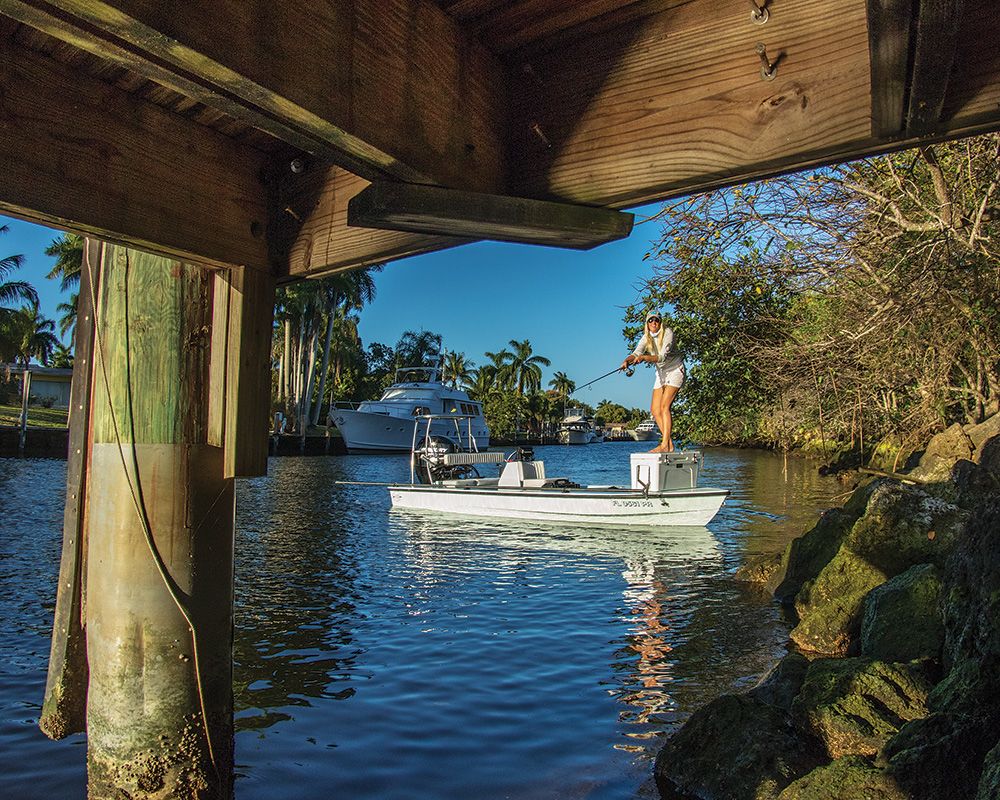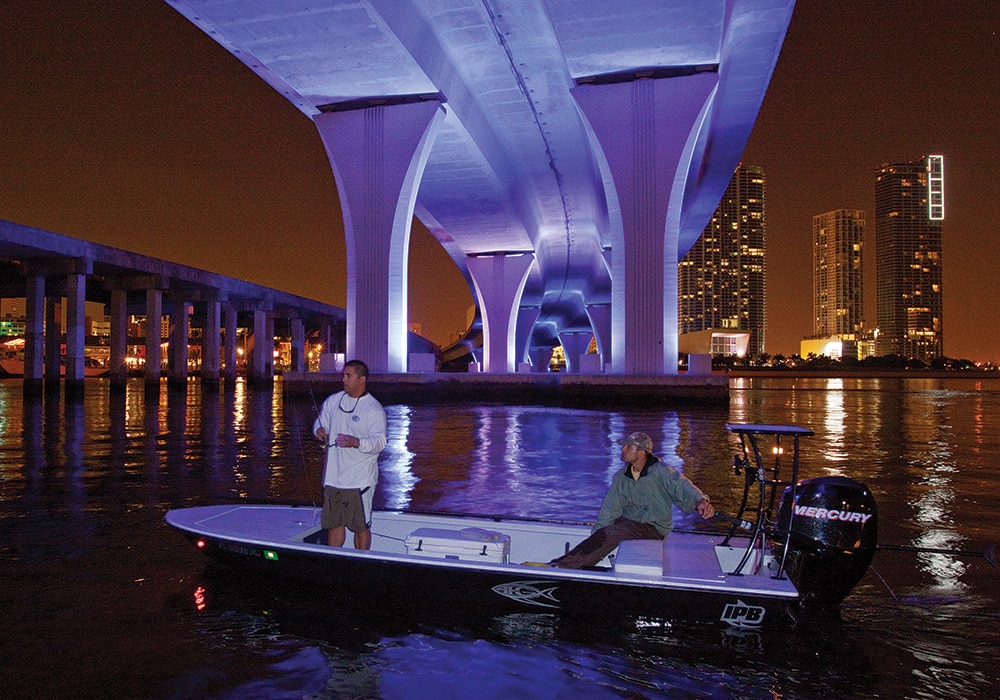
Bridges bring out the beasts of inshore waters. While high above, causeways provide transportation for millions of commuters; below, the pylons and foundations offer safety and food for marine ambush feeders — an appealing rest stop for full-grown inshore sport fish.
One of the trickiest aspects to fishing bridges involves pulling fish away from the concrete, metal, wood and rubble. If you plan on fishing bridges, make sure your tackle is up to the task. Whether in the Atlantic, Gulf or Pacific, bridge-fishing enthusiasts should utilize the unique mix of deep water, current and structure available underneath local bridges and causeways. The targets and locale might differ, but chances are you can utilize the proven tactics highlighted here.
Fish A Running Tide Around Bridges
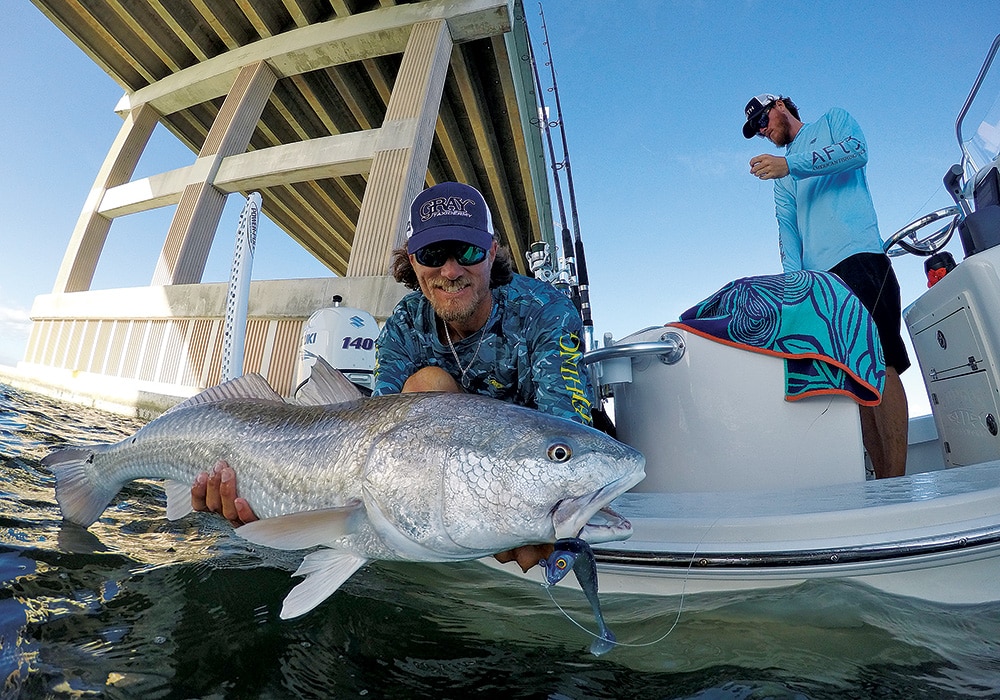
Recently, I joined Capt. Jarrod Tuttle and his friend Jaron Bennett to explore the bridges that span the Indian and Halifax rivers near Daytona Beach, Florida. The targets were redfish, tarpon, snook, goliath grouper and slammer bluefish (that were prepping for their journey back north).
“Each trip, we want to have a variety of live baits ready in the well,” says Tuttle. “Mullet, pinfish, pogies, whitebait and mojarra are all good baits, but you’re never sure what fish want until you drop a couple of baits deep.”
Tuttle targets bridge pilings and fenders with at least 10- to 15-foot depths. He has his favorite areas but isn’t afraid to move around to different pylons to find the best bite. Fishing from his 20-foot Andros, he utilizes a mix of anchoring, drifting or trolling to position near the bridge.
“The Minn Kota Spot-Lock can really come in handy, allowing you to set your position with your trolling motor and hold in one area hands-free,” points out Tuttle.
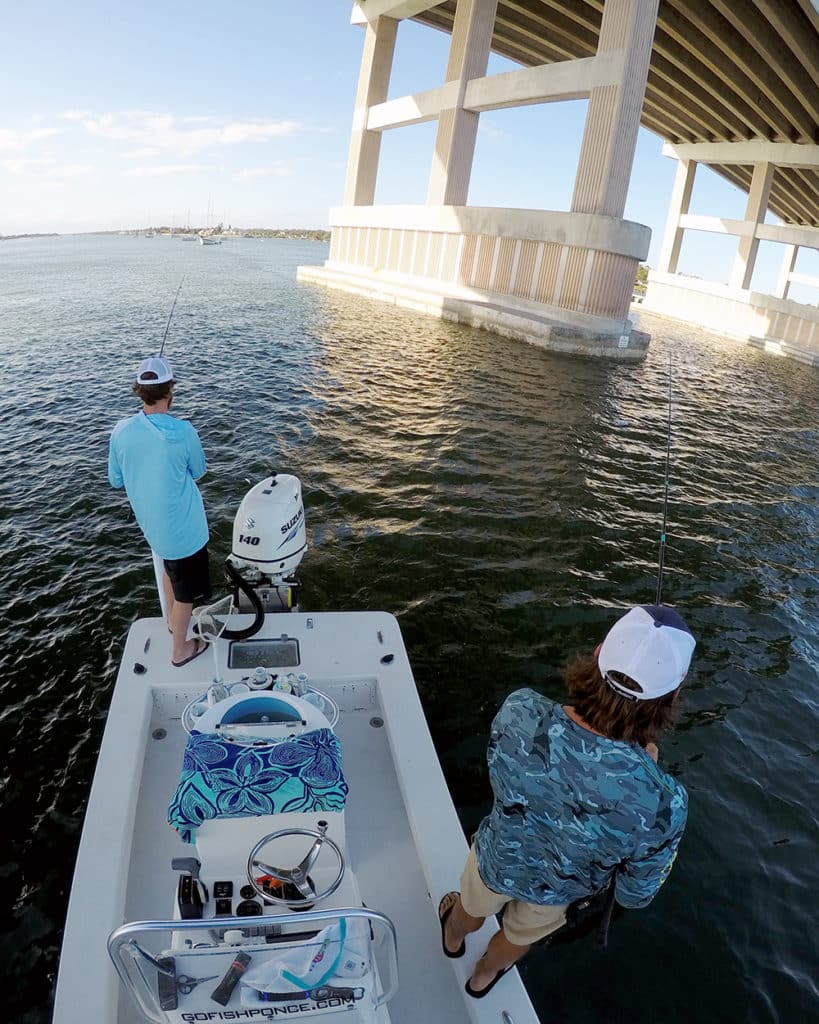
Current is an absolute must; otherwise, Tuttle won’t even consider fishing the bridges. The tides flush the food right to the game fish hiding within or near the structure. The pattern is easy to visualize — game fish rest behind structure, out of the current to conserve energy, and then pounce once a baitfish or crustacean is close enough.
An angler’s number-one job is to re-create this exact scenario with their live bait or lure. Too far away from the structure? You might not get a single bite. Too high in the water column? Nothing will see your presentation.
Bennett anchored us about 15 feet up-current from the concrete structure. Next, Tuttle and Bennett lobbed live pinfish on bottom rigs to separate corners of the same bridge piling. Nearby, two anglers scraped barnacles into the water to attract sheepshead.
I cast a 3⁄8-ounce swimbait far away from the bridge to allow the tide to bring it back into the strike zone naturally.
Almost immediately, something whacked my jig. I fought the fish cautiously around the boat and anchor line until it finally revealed itself as an oversize redfish.
“The way it was fighting, I would have guessed jack crevalle, redfish or a huge bluefish,” said Tuttle. “You’re never sure what you might catch around the bridges.”
Bridge Fishing Tackle and Rigs
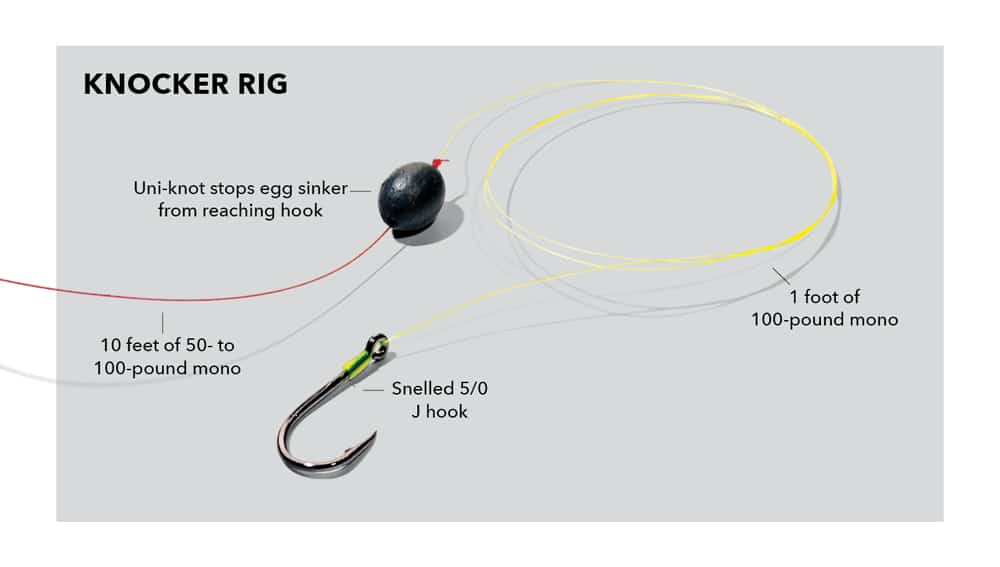
Bennett and Tuttle prefer different bottom rigs.
“I was losing so much terminal tackle [to the structure] that I switched to a [single] dropper loop rig with a bank sinker,” says Bennett. “I didn’t lose as much leader, hooks and weights after that.”
Bennett’s bait sits about a foot off the bottom. Tuttle’s bait also sits a foot off bottom, but he uses a sliding sinker rig. Neither angler uses a swivel. In its place, both start with 10 feet of 50- to 100-pound mono leader tied to the main line with an FG knot. Tuttle’s rig also incorporates 1 foot of 100-pound mono tied at the tag end of his leader with a uni-knot. The uni-knot stops the weight from sliding farther down the line toward the hook.
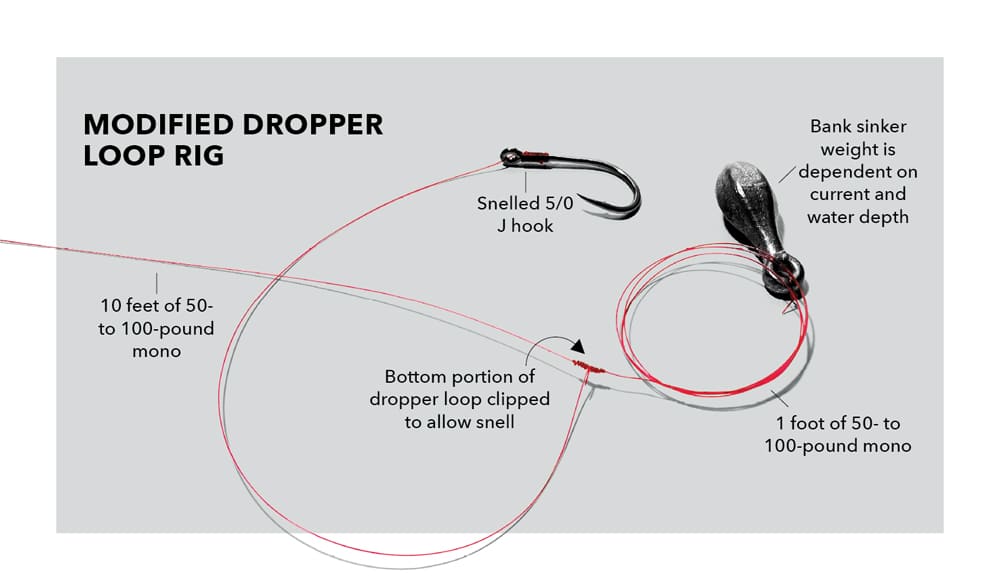
“The 10 feet [of leader] allows me to re-tie three different times before I have to tie a new FG knot,” says Bennett.
The weight of the leader is directly related to the clarity of the water. “When it really clears up, we have to drop down to 50-pound-test to get a bite,” says Tuttle. “But then we also lose more fish with the lighter leader.”
Both regularly use 8-plus ounces of lead to combat heavy current — Bennett prefers bank sinkers, while Tuttle uses egg sinkers.
“With an egg sinker, I can better control fish at boat-side,” says Tuttle. “Tarpon and snook jump like crazy, but the in-line weight doesn’t fly around as much as a bank sinker.”
At our first stop, Bennett landed two goliath grouper under 30 pounds while everyone else missed a number of different takes. I say “takes” because snook, tarpon, redfish and grouper will thump your bait and then head straight for the structure. This behavior forces Tuttle and Bennett to use thick-gauge 5/0 live-bait hooks instead of circle hooks.
“When you feel that thump, you have to set the hook and start cranking right away,” says Tuttle. “If you let them take the bait with a circle hook, your chances of getting a fish away from the structure are low.”
Night Bridge Fishing
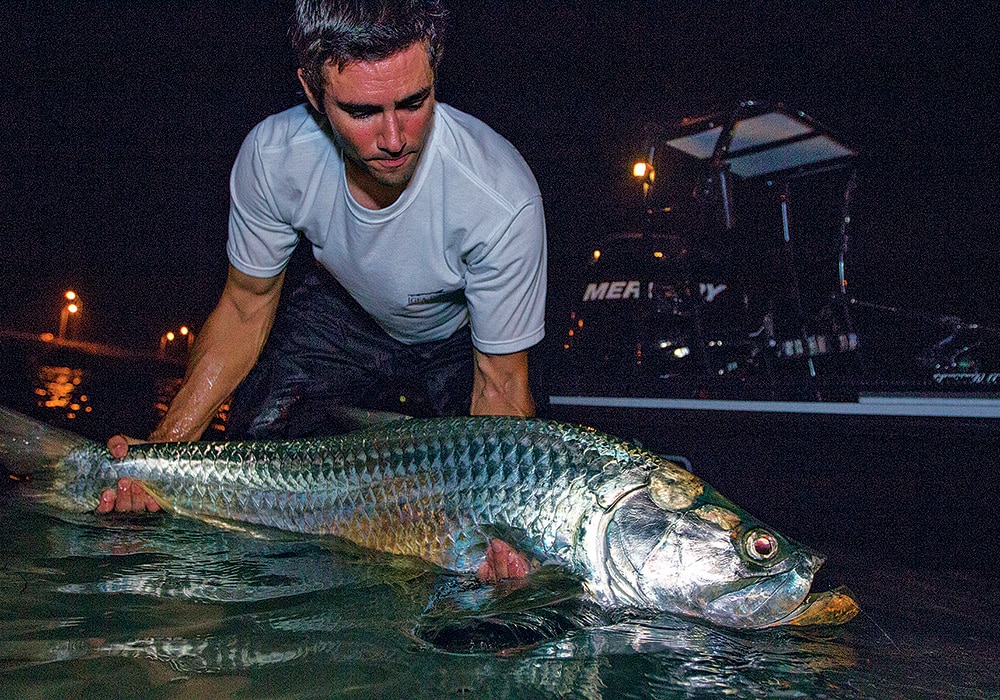
The best time to hit the bridges is when the lights go out. I’ve fished at night for giant redfish along the deepwater pilings that cross East Bay near Panama City Beach, for massive snook around bridges in Stuart, Florida, and for tarpon outside the bridge shadow lines in Miami. Striped bass, seatrout and black drum also come out to feed, depending on your region. I’d say most inshore species feed better at night than during daylight hours, hence the popularity of dock-light fishing.
“We really see the tarpon and snook bite turn on after dark,” says Tuttle. “We’ll use the same baits and tactics, but we’ll also throw giant swimbaits with high success.”
Nighttime also sees some fish move closer to the surface near bridges. Topwater lures, or free-lined live shrimp drifted back toward a bridge shadow line, are popular for redfish and tarpon. Plus, any bright bridge lights along the fenders are likely to attract baitfish and game fish.
When casting lures, make sure the lure swims with the current, says Tuttle. With live baits, drift them back with the current. Consider your boat position around a bridge: You might set up up-current to drop back live baits or down-current to cast lures.
The first nighttime tarpon I ever hooked was on a purple demon MirrOlure sinking twitchbait that a friend recommended. Ever since, purple has been a productive night color, in my experience. Tuttle prefers chartreuse at times.
“On our most recent trip, the snook and tarpon were annihilating the limetreuse swimbaits jigged slowly along the bottom,” he said. “We tried the purple SpoolTek jigs, but the hits we had were more like body checks rather than committed bites. I always make sure to have a number of different color options on the boat.”
Targeting Goliath Grouper
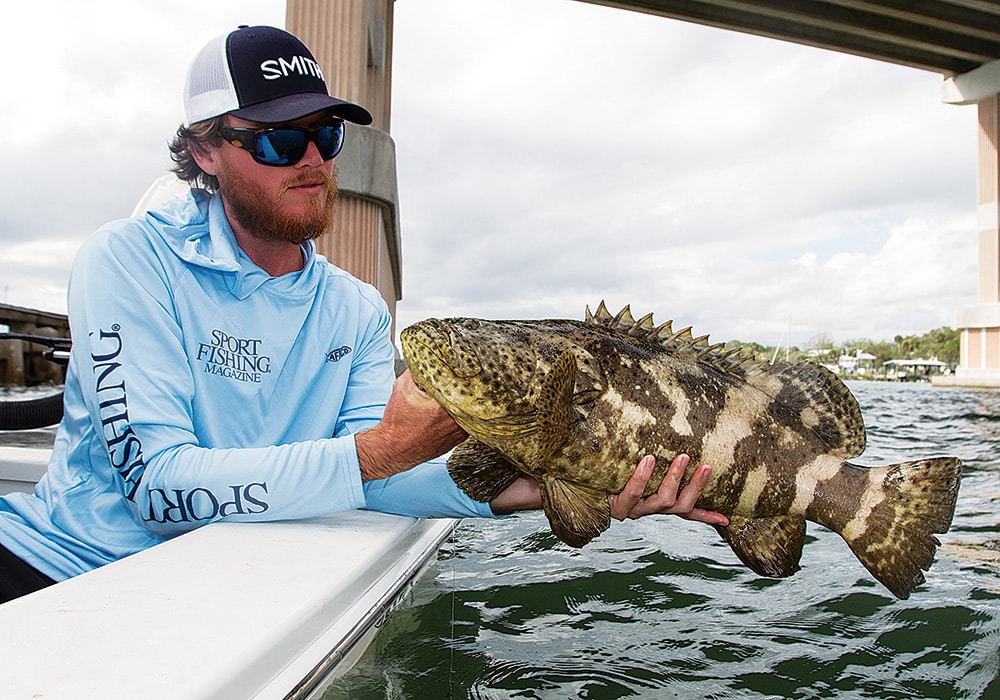
Some fish hooked near bridges simply won’t budge, rocked up before an angler has a chance to blink. That’s especially true in Florida waters where the protected goliath grouper is resurging, and pushing farther north in the Gulf and toward North Carolina in the Atlantic.
Tuttle now brings along a Penn 6/0 Senator, rigged with 250-pound braid, and pairs it with a 100-pound custom conventional rod. He uses 100-pound leader, a 10/0 J hook and a live jack crevalle as bait. That’s the tackle necessary to pull large juvenile goliath grouper, which easily reach 100 pounds, from bridge structure. Adult goliaths, which can surpass 800 pounds, head to offshore waters when fully mature.
“Most smaller [goliath grouper] we catch on normal bridge-fishing tackle,” says Tuttle. “But there are some bridges around here that regularly hold huge goliaths — that’s when we’ll use the Penn 6/0, and even then we don’t often get them to the boat.”
Tuttle’s noticed goliaths are such a regular occurrence around east central Florida bridges that his repeat fishing customers now ask to catch one during a trip.
Goliath grouper are currently a protected species, so they can’t be kept or brought into the boat. There is talk by the Florida Fish and Wildlife Conservation Commission of a limited goliath grouper harvest season in 2018, but nothing has been approved or signed into law at the time of this writing.
Try Dock Fishing
